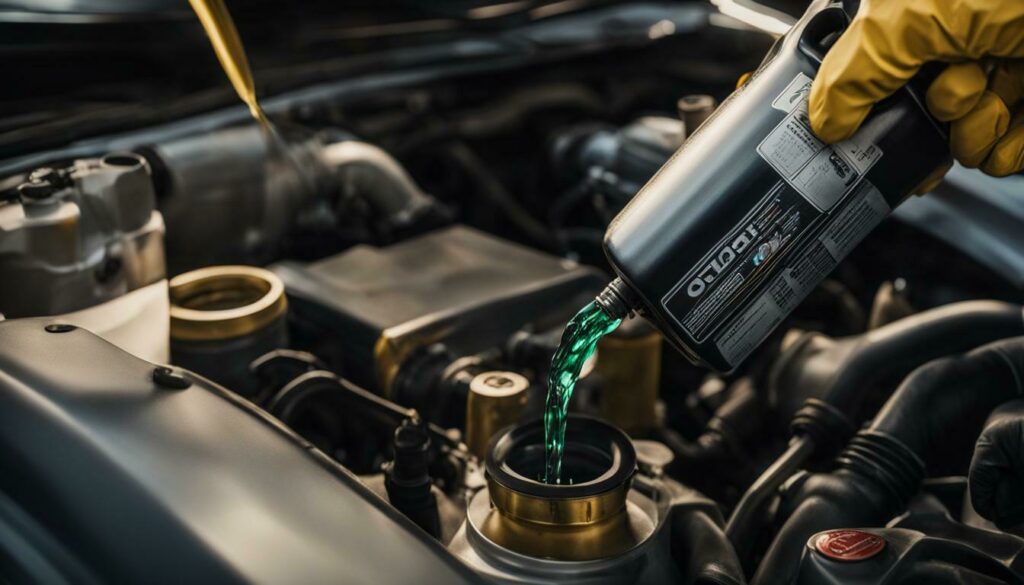Are you experiencing milky oil in your engine? This common issue occurs when coolant mixes with engine oil, resulting in a milky or foamy appearance. Driving with milky oil can cause serious damage to your engine and lead to potential breakdowns.

But don’t worry, fixing milky oil is easy as long as you follow the simple steps in this article.
Understanding Milky Oil and Its Causes
Before we dive into the solutions, it’s important to understand what milky oil is and what causes it. Milky oil is a condition where the engine oil becomes contaminated with coolant, resulting in a milky appearance. This contamination is commonly caused by a coolant leak, often due to a faulty head gasket or a cracked engine block.
The head gasket separates the engine block and cylinder head and prevents coolant and oil from mixing. However, when the gasket fails, coolant can leak into the engine oil, resulting in milky oil. Additionally, a cracked engine block can also allow coolant to mix with oil. This mixture can cause extensive damage to the engine if not addressed promptly.
If you suspect that your engine oil is milky, it’s crucial to address the issue immediately. Ignoring milky oil can lead to severe engine damage and costly repairs.
How do you spot milky oil? Keep an eye out for a foamy, milky appearance on the engine oil dipstick or under the oil cap. If you notice these symptoms, it’s essential to take your vehicle to a professional mechanic right away.
In the next section, we’ll discuss the risks of driving with milky oil and what you should do if you encounter this issue.
It’s important to address milky oil promptly and follow the steps to fix it.
The Risks of Driving with Milky Oil
- Reduced lubrication of engine components
- Increased friction and wear on engine components
- Potential engine damage
- Overheating
- Potential breakdowns
For these reasons, it’s essential to address milky oil as soon as possible. The best approach is to follow a three-step process that includes identifying and repairing the coolant leak, flushing the engine to remove the milky oil, and changing the oil and filter.
Step 1: Identify and Repair the Coolant Leak
The first step in fixing milky oil is to identify and repair the source of the coolant leak. Inspect your vehicle for any visible signs of coolant leakage, such as puddles underneath the car or coolant stains on engine components. Common causes include a faulty head gasket or a cracked engine block.
If you are unable to locate the source of the leak, consider using a leak detection product that can help pinpoint the issue. Once the leak is identified, consult a professional mechanic to repair or replace the faulty component.
It’s essential to address the coolant leak as quickly as possible to prevent further contamination of the engine oil. Delay in repairing the leak can lead to costly repairs and possible engine failure.
Step 2: Flush the Engine to Remove Milky Oil
After repairing the coolant leak, the next step is to flush the engine to remove the milky oil. Engine flushing is a crucial step in the process of fixing milky oil. It involves using a specialized cleaning solution to remove any remaining coolant contamination from the engine.
The flush procedure typically involves adding the cleaning solution to the engine oil reservoir and running the engine for a specified period. This process helps remove any remaining coolant traces and debris from the engine. After running the engine, the contaminated oil is drained, and the engine is thoroughly cleaned to remove any remaining sludge or deposits.
It is essential to follow the manufacturer’s guidelines and perform a thorough engine flush to ensure all traces of milky oil are eliminated. The engine flush can help restore proper lubrication and prevent further damage to the engine.
During the engine cleaning process, all coolant remnants must be removed. Coolant removal is crucial to ensure the engine operates smoothly.
Step 3: Change the Oil and Filter
Once the engine flush is complete, it’s crucial to change the oil and filter. Drain the milky oil completely and replace it with fresh, high-quality engine oil. Additionally, replace the oil filter to ensure that any residual contaminants are removed from the system. This step helps restore proper lubrication and prevents further damage to the engine.
When changing the oil, use the recommended viscosity and type of oil specified in your vehicle’s owner manual. Fresh oil provides better lubrication and helps keep the engine clean. It’s also important to replace the oil filter, as it traps debris and contaminants that can damage the engine.
Remember to dispose of the old oil and filter properly. Many auto parts stores and service centers offer oil recycling services, or you can ask your local waste management facility for disposal instructions.
If you’re uncertain about the oil change process or not comfortable working with engines, consult a professional mechanic to complete the oil change and filter replacement.
Changing the oil and filter is a crucial step in fixing milky oil in your engine. It’s an effective way to ensure proper lubrication and prevent further damage to your engine.
Key Takeaways
- Milky oil occurs when coolant mixes with engine oil, resulting in a milky or foamy appearance.
- Identifying and repairing the source of the coolant leak is the first step to fix milky oil.
- Flushing the engine and changing the oil and filter are crucial steps in fixing milky oil.
- Driving with milky oil can cause serious engine damage, overheating, and potential breakdowns.
- Regular vehicle maintenance, including coolant replacements and inspections, can help prevent milky oil.
Tips to Prevent Milky Oil
To prevent milky oil from occurring in the future, it’s important to take proper care of your vehicle’s coolant system. Regular maintenance and preventive measures can go a long way in avoiding this issue. Here are a few tips to keep in mind:
- Perform Regular Inspections: Regularly inspect your coolant system for any signs of leaks or issues. Look for any visible signs of coolant leakage, such as puddles underneath the car or coolant stains on engine components.
- Maintain Coolant System: Keep up with recommended maintenance schedules, including coolant replacements, to ensure that your coolant system is functioning correctly.
- Inspect the Head Gasket: Inspect the head gasket regularly for signs of wear and tear. If you notice any issues, consult a professional mechanic to have it repaired or replaced.
- Preventive Measures: Take preventive measures by using high-quality coolant and monitoring your vehicle’s temperature gauges. This will help you catch any issues early and prevent milky oil from occurring.
By staying proactive and taking care of your vehicle, you can minimize the chances of encountering milky oil in the future.
Remember, regular maintenance and prompt attention to any issues can help prevent milky oil and keep your engine running smoothly.
Frequently Asked Questions (FAQ)
Still have questions about milky oil in your engine? Check out these commonly asked questions and their answers.
Q: What causes milky oil in an engine?
A: Milky oil in an engine is usually caused by a coolant leak. When coolant leaks into the oil, it mixes with the oil and turns it milky. This can be caused by a variety of things, such as a blown head gasket, a cracked cylinder head, or a damaged radiator.
Q: What are the symptoms of milky oil?
A: The most obvious symptom of milky oil is the milky appearance of the oil itself. Other symptoms may include:
- Engine overheating
- White smoke coming from the exhaust
- Loss of coolant
- Rough engine idle
- Decreased engine performance
Q: How can I fix milky oil?
A: The first step is to identify and repair the source of the coolant leak. Once the leak is repaired, you will need to flush the engine to remove the milky oil. This can be done by using a commercial engine flush product or by having the engine flushed by a professional mechanic.
Q: Can I drive with milky oil?
A: It is not advisable to drive with milky oil. Milky oil can clog the engine’s oil passages and cause serious damage. If you notice that your oil is milky, it is important to have the problem diagnosed and repaired as soon as possible.
Q: How can I prevent milky oil?
A: The best way to prevent milky oil is to have your car regularly serviced by a qualified mechanic. This will help to identify and repair any potential problems before they cause serious damage. You should also check your coolant level regularly and top it off as needed.
I hope this FAQ is helpful. If you have any other questions, please feel free to ask.
Conclusion
This article contains general information about milky oil in engines and how to fix it. However, every vehicle and situation is unique. Therefore, the solutions provided may not be suitable for all vehicles or situations.
If you have any concerns or questions related to milky oil or any other automotive issue, please consult a qualified mechanic or technician for professional advice.


